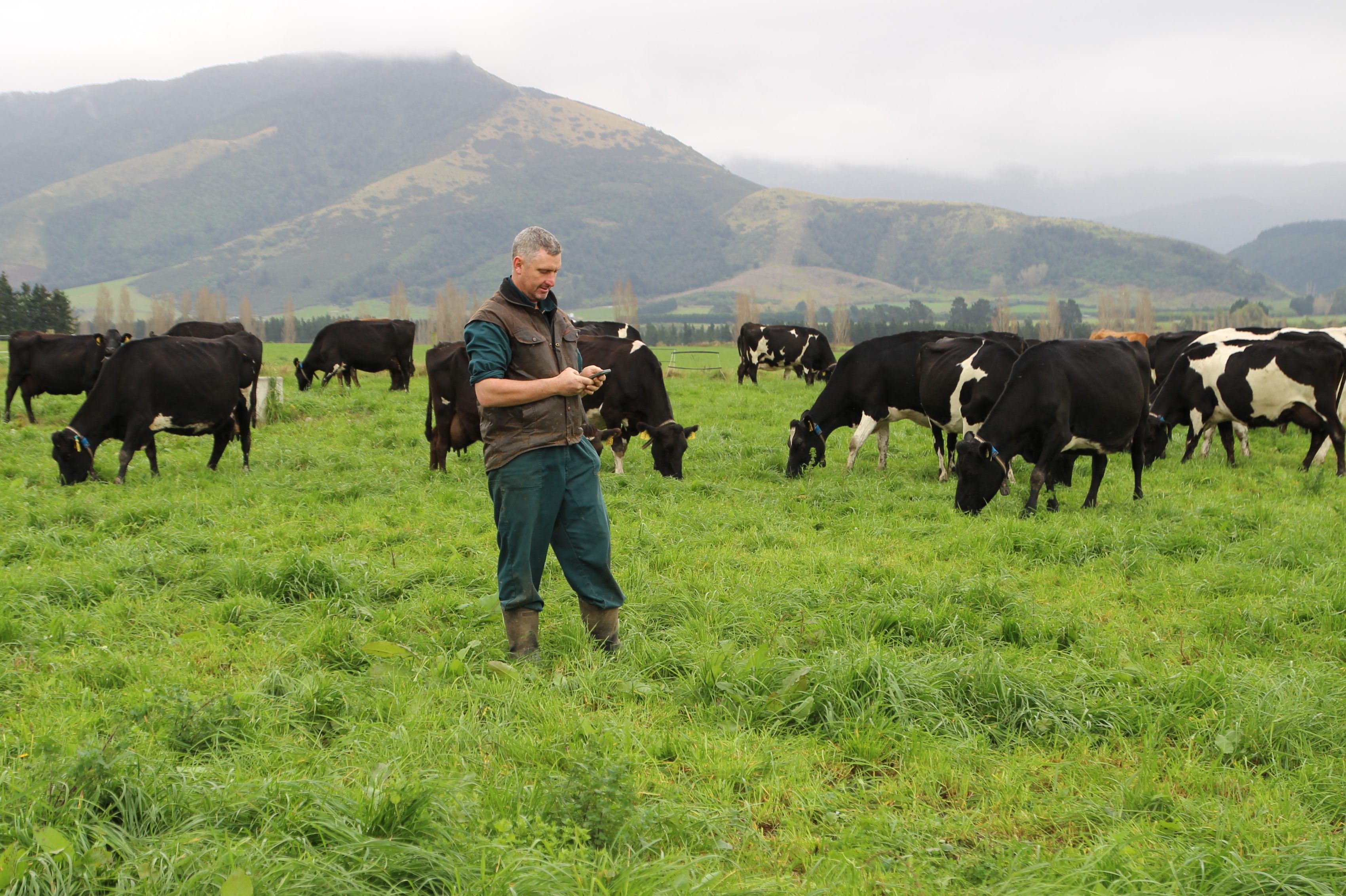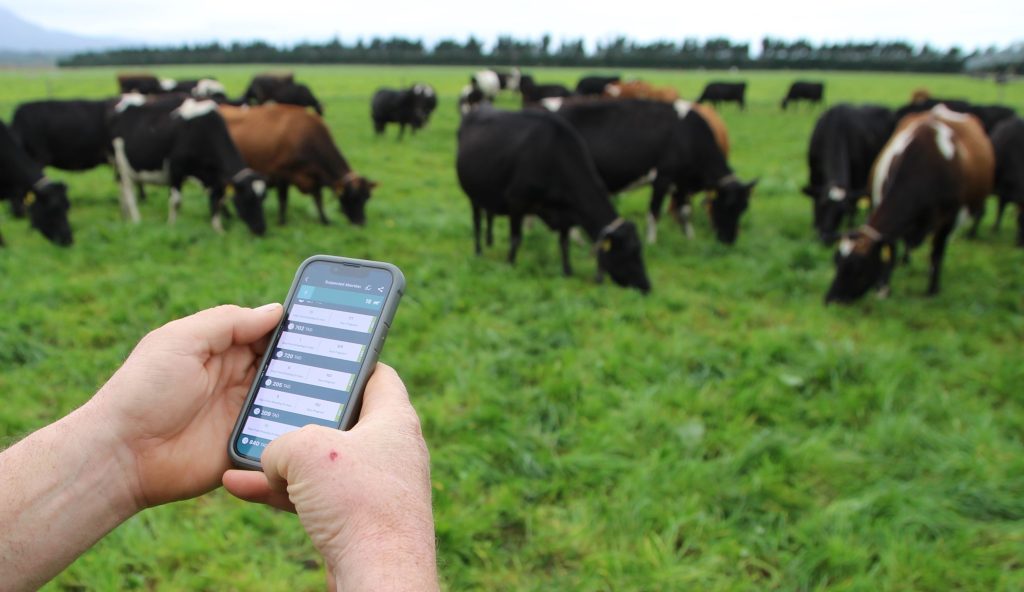

Darcy Bishop | We know cow
Technology is playing an increasing role in delivering a more sustainable level of performance for Canterbury dairy farmer Darcy Bishop.
| Location | Farm Size | Herd Size |
| Oxford, Canterbury | 270ha milking platform, 335ha total area including 10ha water storage pond. | 930-950 cows at peak |
Benefits
- Peace of mind – more certainty cows are well fed
- Quicker genetic gain through more use of sexed semen
- Future proofing farm business
- Less pressure on staff, better retention
Technology is playing an increasing role in delivering a more sustainable level of performance for Canterbury dairy farmer Darcy Bishop.
He bought his 320ha (effective) partly-irrigated dairy farm in 2014, heading south from Waikato to Oxford to build scale and milk a herd of 930-950 cows at peak each season.
He just bought 50ha of adjoining land and 10ha of it will be included in the milking platform. Replacement stock will graze the balance, reducing the time replacements are grazed off farm.
After several years of pushing production, he’s content with production of around 445,000kg milk solids per season and feels he’s found the farm’s sweet spot is 3.5 cows/ha.
“Our idea is not to milk more cows but do everything better and take some pressure off so we’re not living on a knife edge all the time,” Darcy says.
Canterbury’s label as a consistent dairy performer has been challenged in the past two years. In their 2020-21 season, they produced 449,000kg MS but last year production dropped to their worst season ever of 429,000kg MS when the climate delivered a run of wet cool months. This season, they are on track to hit 445,000kg MS.
Allflex Monitoring collars and readers were installed in September 2021. In spite of two consecutive difficult mating periods since, Darcy says the collars have been a very worthwhile investment.
One of the most significant developments since adding the collars is a switch to using sexed semen for the first time. At around $50/ straw, he always felt it was too expensive.
“But with the collars, you know a cow is cycling, and you know if she’s in calf 35 days later, so you feel like that $50 straw you’re using is worth the investment.”
Using sexed semen for the first three weeks of mating also means he has been able to double the number of cows mated to beef sires from 20% to 40% of the herd and gain extra income from the sale of more beef-cross calves.
“Switching to using sexed semen is game changing f or me because if the rules ever change for us in the future, I’ve already done a decade of breeding only from my top cows in the herd so if we have to reduce cow numbers, I can keep 800 of the best cows in the country and milk from them,” he says.
“The collars have given me a big hand to fast track genetic gain in my herd.”
He works with his LIC rep to combine herd testing and monitoring data to produce a mating plan which is colour-coded for ease of visual selection and links straight to his Protrack drafting system.
He’s aiming to lift the conception rate to sexed semen from last season’s 49% to 52% for the 2023 mating with better feeding leading into mating this spring.
With Allflex monitoring technology in place, mating has become a less stressful period in the year for Darcy and his team of three full-time staff.
“The first three weeks are still full on busy, and I like to be at the shed to make sure the right decisions are made. But I’m not having to get up at 4am every morning and spend three hours-plus on the stand making sure the right cows are selected as they pass through the shed.
“I literally don’t need to do anything now. I can get up in the morning, have a coffee, go to the shed and there’s a group of maybe 50 cows waiting for me. I go through their data and generally most will be on heat. It’s that simple.”
“It’s made everyone happier in the team too. We’re all a little busier than usual, but it’s more manageable now.”
Darcy likes to use the rumination data to back up his own subjective assessments of how feeding is going.
“If you know in your gut that you’re not feeding cows properly, the rumination data shows it. We’re able to make better decisions on feeding and we can make them earlier than we would just on gut feel.”
Almost at the end of his second season with the collars on his herd, Darcy says he is gaining more confidence in using the data they deliver in his dayto-day feeding management of the herd.
“What I realise now is you learn so much more in the second year from the rumination and health reports, and if you really want to make a great return from them, you have to be prepared to put some time into it.”
“Like all technology you only get out of it what you put in. But it’s amazing when you do that.”
The farm’s veterinarian has direct access to the monitoring data and checks in weekly, especially at
critical times of the year.
On the advice of their veterinarian and after getting information from his Allflex Training Specialist, Darcy has introduced a two-stage transition approach to prepare cows for the twice-a-day milking mob.

“The collars have given me a big hand to fast track genetic gain in my herd.”
Darcy bishop
Cows enter a colostrum herd for the first four days after calving and then move to a transition herd for six days where they are milked once each day, before entering the main mob and being milked twice a day.
“With collars, you can monitor their rumination data so you know when they reach the right level to move
on. Cows need longer to recover from having their calf so giving them 10 days means they hit ground running when go into the twice-a-day herd.”
“If they drop rumination once they get to the main herd, you can pull them back out to the transition herd again if required.”
Darcy says the collars have helped him find a better balance between work and home life.
“I’ve gone from often feeling tired through the season to being able to spend more time with my family. I have three children so it’s a lot easier for me to support them with sport and take time off the farm now.”
Darcy considered two other cow monitoring technologies before settling on the Allflex Monitoring option. In the end, he eliminated one on cost and rejected the other on inferior compatibility with his existing Protrack auto-drafting gate at the dairy shed.
“For me, choosing Allflex was the easy option and I knew it was fully compatible with my existing Protrack drafting gate and I had all the technology in my shed from LIC.
Training and support from his local Allflex trainer have been exceptional.
“Allflex Monitoring collars gives me peace of mind. I know when my cows are well fed and when you get that right, you don’t have to intervene.”
Thanks to NZ Farm Life Media for working with us on the We know cow series to deliver you this in-depth analysis on Allflex / SenseHub Monitoring Solutions. Read articles from NZ Farm Life Media’s Dairy Exporter here.
If you would like our indicative pricing flyer emailed to you and or to book your farm visit, please complete the below enquiry form.
Monitoring Solutions – Branding Explanation
The brand names for our monitoring solution have been subject to changes since recording our videos and farmer stories.
MSD Animal Health, a division of the MSD group of companies under Merck & Co., Inc., Rahway, NJ., U.S.A. and a global provider of animal health pharmaceuticals and technologies, purchased the Allflex New Zealand business in 2019 (including certain SCR-branded animal monitoring technologies). At the time, Allflex animal monitoring solutions were known as Allflex collars and the relevant desktop-based software was HeatTime Pro (both of which you may hear about in this video). The dairy monitoring solutions are now branded SenseHub® Dairy – MSD Animal Health’s desktop-based software is now known as Dataflow II™ and cloud-based monitoring software is known as a SenseHub® Dairy solution. Allflex remains the brand name which represents our identification solutions.

